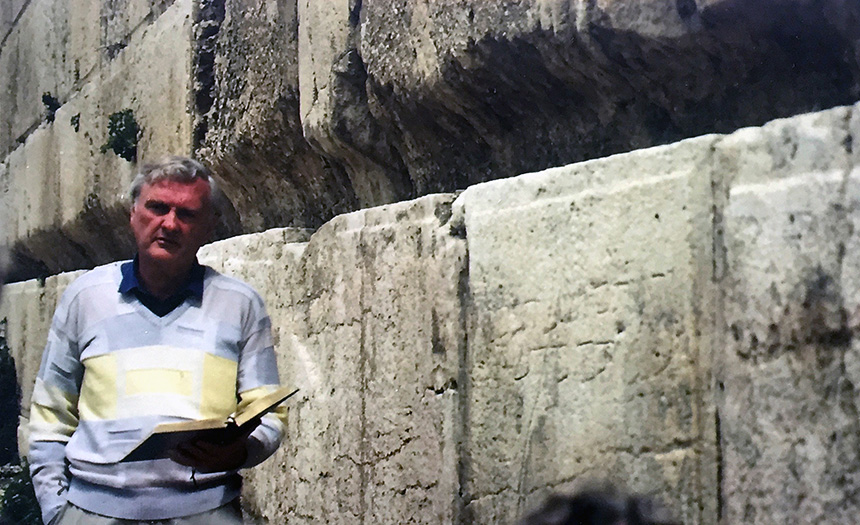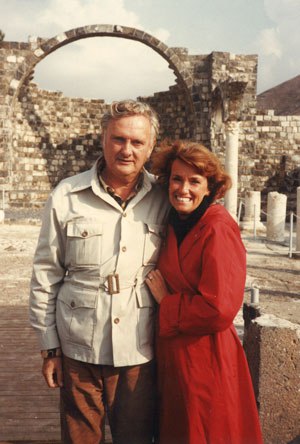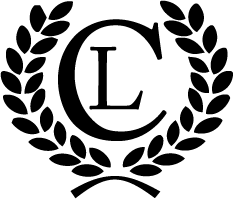To purchase available publications and collaborate with the Library please go to our SHOP. Thank you.
Publications
B. Cobbey Crisler
Biography

B. Cobbey Crisler’s path to his ultimate calling as a Biblical scholar, like many others, was not a direct one. After receiving his Bachelor of Arts degree with a major in International Government from Harvard University, Class of 1954, he served as a lieutenant in the Air Force as part of the ROTC program. While serving on the Board of Trustees of his secondary school alma mater, the Daycroft School in Greenwich, Connecticut, he was invited to assume the position of President.
In addition to his other duties, Cobbey appointed himself to the tasks of biblical scholarship, learning ancient Hebrew and Greek in order to teach Scripture and Biblical Studies to Daycroft students. During those years we led students who had a keen interest in archaeology as well on a major archaeological excavation at Caesarea Maritima in Palestine. This was part of a national consortium of American colleges and universities.
His own research of the original texts in ancient Greek and Hebrew led to producing audiotape series titled “Search the Scriptures.” One Christmas, while we were visiting prominent sites of antiquity in Palestine, Cobbey tested ideas about the natural acoustical properties on hillsides where large crowds gathered to listen. The results were so dramatic that when we returned to America he was able to persuade the Cambridge, Massachusetts acoustics firm, Bolt Beranek and Newman to send Engineer Mark Myles with him to electronically test the sites we explored in December. Later the electronic tests with his commentary were published in the 1976 edition of the Biblical Archaeologist under the title “The Acoustics and Crowd Capacity of Natural Theaters in Palestine.” In 1986, a biography of B. Cobbey Crisler was presented in the book, Who’s Who in Biblical Archaeology, a compilation of professional men and women of superior achievement and status devoted to a better understanding of Biblical texts. Subsequently, he also co-authored two books with Professor Robert J. Bull, Director of the Caesarea Maritima excavations titled Come See the Place: The Holy Land Jesus Knew and Fishers of Men: The Way of the Apostles, photography by Gordon Converse.
At Cobbey’s passing in 1988, we decided to establish a scholarship in his name at Harvard Divinity School, which enables students each year to matriculate in the fields of archaeology and Biblical scholarship in Asia Minor (modern Turkey). With the establishment of the Crisler Library in Ephesos (CLE) as his legacy, the Board of Trustees and I are assured that his standards for scholarship will be perpetuated toward projects that he would have been dynamically involved.
His discovery of a menorah graffiti on the steps of the Crisler Library at Ephesos in 1978 was part of his wider attempt to locate areas of the city familiar to Paul, Timothy, John and Luke. In pursuit of that goal, CLE has been seriously involved in a collaborative effort with the Austrian Archaeological Institute to locate through geo-radar techniques and excavation this particular area of the ancient site.
Collected works
Description of the recorded lectures
The following is a list of the CD's available of talks he gave live at the archaeological sites in modern Turkey.
The Walk to Emmaus, A Walk Through the Scriptures (from a 3 hr. talk)
Two disciples were leaving Jerusalem after the trial, conviction and crucifixion of Jesus Christ. A “Strange” joins them. In conversation, the Scriptures are suddenly illuminated. Who is this Stranger? Why does his message From the Old Testament light a spark? How can the spread of Christianity be traced to this single event?
The Case of Job (from a 6 hr. talk)
Job gives us a vision of how to solve problems of human nature. Thoughts can constitute a mental courtroom. Who is the judge, prosecutor, defense attorney? What witnesses do we allow to testify?
Heal the Sick: A Scriptural Record (from a 6 hr. talk)
Spiritual healing through prayer in the Old and New Testaments. How did Jesus use this methodology? Is it relevant today?
A Visit with the Beloved Disciple (from a 6 hr. talk)
The disciple closest in thought to The Master Christian. Discover his deep spirituality.
Jesus and the Equality of Woman (from a 3 hr. talk)
How did Jesus actually regard Women? What did he believe? Jesus: a pioneer in the recognition of womanhood’s true status.
Auditing the Master: A Tax Collector’s Report (Gospel of Matthew from a 6 hr. talk)
Matthew is interested in Old Testament prophecies. Jesus’ mission in healing as a fulfillment of God’s law. Jesus’ teachings and example illustrated in the Sermon on the Mount and the Kingdom of Heaven, a tapestry of his life seen in church doctrine, discipline and worship.
What Mark Recorded (from a 4 hr. talk)
Mark is primarily recognized as the earliest Gospel and our major source of information concerning Jesus’ ministry. What is the good news Mark wants his listeners to understand? What is the church’s missionary purpose?
Song of the Lamb (from a 1 hr. talk)
Discover Jesus’ Sermon on the Mount, what true Christian practice is as defined by Jesus.
As Researched by Luke (from a 6 hr. talk)
Luke puts Jesus on the world map. He recounts the history of Jesus to confirm with certainty all of what the early Christian followers had been taught.
The Church: Its Scriptural Continuity (from a 6 hr. talk)
When did church-consciousness awaken? How did it develop: The dawn of this idea is traced From Genesis to Revelation with emphasis on church problems and their solutions.
The Holy City: Its Biblical Basis and Development (from a 6 hr. talk)
The Bible does not leave Jerusalem where we find it in its beginnings. The New Jerusalem in Jesus’ vision in Revelation is built upon unity and love, built for solutions to the world’s problems.
The Holy Ghost: Its Scriptural Role (from a 2 hr. talk)
Is the Holy Ghost an influence, a power, a presence? What does prayer have to do with the concept?
The Gethsemane Decision (from a 3 hr. talk)
Jesus faced the culminating crisis of his career and made a decision. Was it old or new? Does humanity have to face this same decision?
God and Man: Their Biblical Relationship (from a 3 hr. talk)
This issue begins with Jesus’ radical challenge, “Judge not according to the appearance.” What basis exists for a Relationship between God and man – especially if it is not a visible One?
War in Heaven: The Conquest of Inner Space (from a 2 hr. talk)
Conflict begins in Genesis with the serpent and closes in the Apocalpyse with the dragon. What practical significance lies behind such Scriptural metaphor? The dragon’s tail reaches for the stars of heaven. Is this Star Wars battleground as close as consciousness? In our cosmic strainings to conquer outer space, have we overlooked Biblical priority – the conquest of inner space?
Deity and devil in the Scriptures (from a 3 hr. talk)
What is God’s nature as revealed through the patriarchs, the prophets, Jesus and the apostles? Does Scripture provide for an influence opposite to God’s nature to exist side-by side?
The Remnant (from a 2 hr. talk)
What is the Biblical definition of remnant? Can we think of it as comforting? How do we know if we qualify as part of the remnant? Is there a need for a remnant?
Secret of His Tabernacle (from a 2 hr. talk)
What possible relevance to the solution of today’s problems can we find in pages of Scriptural detail about the furniture of the Tabernacle? Does the Psalmist hint at the answer when he writes that part of the secret of the tabernacle is man himself?
Simon Peter: The Character of a Disciple (from a 3 hr. talk)
How does the Bible regard human character? What did the change from Simon to Peter signify? Is there something of Simon in each of us? Has each of us the potential of being a Peter?
How Christ Jesus Saw Himself (from a 3 hr. talk)
In John’s Gospel, Jesus is recorded as saying, “If I bear witness of myself, my witness is not true.” “Though I bear record of myself, yet my record is true.” “I and my Father are one… my Father is greater than I.” Are these blatant contradictions or is there deep spiritual consistency in context?
Leaves of the Tree: Prescriptions from Psalms (from a 3 hr. talk)
The word of God as medicine as prescribed in the Book of Psalms. What has given the Psalms such relevance in identifying and reaching the human need?
Freedom: A Biblical Definition (from a 3 hr. talk)
According to the Bible there is a necessity to be God’s servant –(the word in Greek means “slave”!) Why does the Bible define freedom in the vocabulary of subjection? Explore Scriptural texts that link man fetterlessly to “the Spirit of the Lord” where, we are told “is liberty.”
Apocalyptic Pictures: Prophecy and Parody (from a 5 hr. talk)
Dramas foreshadowed in the Old Testament come to a breath-taking climax in the final book of the Bible. The Bible communicates through the language of images and symbols. Can we reach that inspired level of thought where we understand the clear vision of the Revelator?
Glory: Divine Nature in the Bible (from a 3 hr. talk)
What is this state called glory? Is it a present reality or just pious hope? Moses’ face shone, Jesus was transfigured… far from limiting “glory” to a select few. The Bible states God’s purpose in “bringing many sons unto glory” and assures, “then shall we also appear with him in glory.”
The Seven Churches in Revelation: A compilation of talks given at the archaeological sites in modern Turkey.
Books in collaboration
Come See the Place: The Holy Land Jesus Knew, co-authored with Professor Robert J. Bull.
Fishers of Men: The Way of the Apostles, co-authored with Professor Robert J. Bull, photography by Gordon Converse.
Janet V. Crisler
Biography

Though a music major in college, after marriage to her beloved B. Cobbey Crisler interests turned to archaeology during significant field work at Caesarea Maritima, a port city on the Mediterranean Sea built by Herod the Great (circa 22 BC to 12 AD) during his tenure representing Rome in Palestine. From one of her field assignments evaluating the kinds of crops raised and foods prepared during the early first century she was encouraged by her husband to write a cookbook ultimately called Loaves and Fishes: Foods of Bible Times; co-authored with Malvina Kinard, Founder of Cooks Corners Cooking Schools. Her would be mentor urged her to teach Middle Eastern cuisine at Cooks Corners, prefaced with lessons at the Cordon Bleu in Paris for qualification. This event was followed by an article in Bon Appetite magazine (February 1977) featuring one of her cooking classes at Cooks Corners.
The Crislers began spending more time in Palestine giving Janet time for private cooking lessons at the home of Nima Gabriel, a Palestinian lady living in Bethlehem. Mrs. Gabriel had been a long time cooking teacher at the YMCA in East Jerusalem for foreigners who wanted to learn the unique cuisine of Palestine. Events developed towards Janet importing from Palestine, two prominent spices to the US ultimately prepared for 5 products she sold at the Bloomingdate’s Gourmet Food Dept. in New York City.
When Cobbey Crisler died in 1988 her world collapsed and she moved to Salzburg, Austria for solace in the world of music. In 2003, wanting to leave a tangible legacy for her beloved husband at one of his “discovery sites”, she established, founded and became president of the Crisler Library at Ephesos, an archaeological research library for higher education; actually the only American facility of its kind in the region. The Library was blessed with the most supportive and dedicated Board of Trustees continuously but as all agreed the star in the Library’s crown was the International Archaeology Summer Session for a two week program opened to college students worldwide, without borders or nationality. The prestigious faculty of experts was headed up by Prof. Hilke Thur, a long time friend and world renowned architect/archaeologist.
Collected works
Books in collaboration
Loaves and Fishes: Foods of Bible Times, co-authored with Malvina Kinard.
Turkish Delight: Creating a Library in Ephesus, co-authored with Frederic Hunter.
